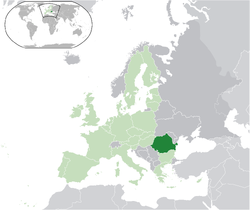|
România | |

|

|
| Anthem Deşteaptă-te, române! | |
| Capital | Bucharest |
| Government | Semi-presidential republic |
| President | |
| - From 2004 | Traian Băsescu |
| Prime Minister | |
| - From 2008 | Emil Boc |
| Legislature | Parliament |
| - Upper house | Senate |
| - Lower house | Chamber of Deputies |
| History | |
| - December 25, 1989 | Revolution |
| EU accession | January 1, 2007 |
| NATO accession | March 29, 2004 |
| Area | 238,391 km² |
| Population | |
| - 2010 | 21,959,278 |
| Density | 92.1/km² |
| GDP | 2010 (PPP) |
| - Total | US$ 258.3 billion |
| - Per capita | US$ 11,767 |
| Currency | Romanian leu |
| v | |
Romania is a semi-presidential republic in Europe.
Background
The principalities of Wallachia and Moldavia - for centuries under the suzerainty of the Turkish Ottoman Empire - secured their autonomy in 1856; they united in 1859 and a few years later adopted the new name of Romania. The country gained recognition of its independence in 1878. It joined the Allied Powers in World War I and acquired new territories - most notably Transylvania - following the conflict. In 1940, Romania allied with the Axis powers and participated in the 1941 German invasion of the USSR. Three years later, overrun by the Soviets, Romania signed an armistice. The post-war Soviet occupation led to the formation of a Communist "people's republic" in 1947 and the abdication of the king. The decades-long rule of dictator Nicolae CEAUSESCU, who took power in 1965, and his Securitate police state became increasingly oppressive and draconian through the 1980s. CEAUSESCU was overthrown and executed in late 1989. Former Communists dominated the government until 1996 when they were swept from power. Romania joined NATO in 2004 and the EU in 2007.[1]
Economy
Romania, which joined the European Union on 1 January 2007, began the transition from Communism in 1989 with a largely obsolete industrial base and a pattern of output unsuited to the country's needs. The country emerged in 2000 from a punishing three-year recession thanks to strong demand in EU export markets. Domestic consumption and investment have fueled strong GDP growth in recent years, but have led to large current account imbalances. Romania's macroeconomic gains have only recently started to spur creation of a middle class and address Romania's widespread poverty. Corruption and red tape continue to handicap its business environment. Inflation rose in 2007-08, driven in part by strong consumer demand and high wage growth, rising energy costs, a nation-wide drought affecting food prices, and a relaxation of fiscal discipline. Romania's GDP contracted markedly in the last quarter of 2008 as the country began to feel the effects of a global downturn in financial markets and trade, and GDP fell more than 7% in 2009, prompting Bucharest to seek a $26 billion emergency assistance package from the IMF, the EU, and other international lenders. Drastic austerity measures, as part of Romania's IMF-led agreement led to a further 1.9% GDP contraction in 2010. The economy is expected to return to positive growth in 2011.[2]
President
- Traian Băsescu (₩) (December 20, 2004 - )
Prime Minister
- Emil Boc (₩) (December 22, 2008 - )
Nation
Romanian Polities
Socialist Republic of Romania (1965-1989)
Satellite state: Romanian Popular Republic (1947-1965)
Kingdom of Romania (1938-1947)
Kingdom of Romania (1918-1938)
Kingdom of Romania (1881-1918)
United Romanian Principalities
Principality of Moldavia
Principality of Wallachia
Neighbouring Nations
References
- Romania: a country study (Library of Congress)
- Romania: a country study (archive.org)
- Romania: Guide to Law Online (Library of Congress)
- The World Factbook (CIA)
- Chiefs of State and Cabinet Members of Foreign Governments (CIA)
- U.S. Department of State
- Australian Government
- European Union
- Inter-Parliamentary Union - Senate
- Inter-Parliamentary Union - Chamber of Deputies
- BBC News Country Profile
- BBC News Time Line
- World Statesmen.org
- International Constitutional Law Project
- Psephos Election Archive
- Wikipedia
